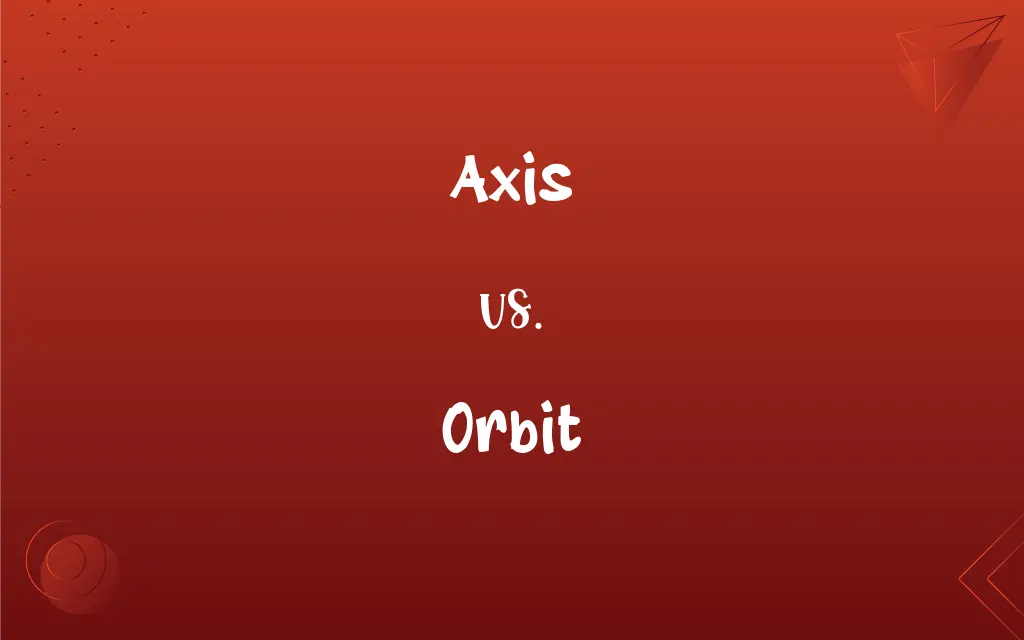Axis vs. Orbit: What's the Difference?
Edited by Aimie Carlson || By Harlon Moss || Updated on November 2, 2023
Axis is an imaginary line an object rotates around; orbit is the curved path one object takes around another due to gravity.

Key Differences
An axis is an imaginary straight line around which an object, like a planet, rotates. An orbit, conversely, is the path that an object follows as it moves around another object in space. Both concepts are central to understanding celestial mechanics but serve different functions in the motion of bodies in space.
When we talk about the Earth's axis, we mean the line that runs from the North Pole to the South Pole, around which Earth spins and gives us day and night. An orbit refers to the Earth’s elliptical path around the Sun, which it completes once every year. While the Earth rotates on its axis, it simultaneously revolves in its orbit.
The tilt of Earth's axis is responsible for the changing seasons as the planet orbits the Sun. If an object in orbit is bound by gravity, the axis is simply the center around which it rotates, not influenced by another object's gravity.
An axis does not necessarily have to relate to celestial bodies; for instance, it can be the spindle of a wheel. Conversely, orbit is specifically used to describe the path of a celestial body or man-made object in space around another body.
In summary, an axis pertains to the rotation of an object around a central line, while an orbit describes the revolution of one object around another along a curved trajectory. These terms highlight different aspects of motion, although both are often used in the context of astronomy.
ADVERTISEMENT
Comparison Chart
Definition
A line about which an object rotates.
A path one object takes around another.
In Astronomy
Earth’s axis causes day and night.
Earth’s orbit results in a year.
Relation to Gravity
Does not depend on gravity.
Depends on the gravitational pull.
Occurrence
Can occur in isolation (a spinning top).
Requires two or more bodies (planet around a star).
Representation
Often represented as a straight line.
Depicted as an elliptical or circular path.
ADVERTISEMENT
Axis and Orbit Definitions
Axis
A fixed reference line for the measurement of coordinates.
The x-axis and y-axis establish a plane in Cartesian coordinates.
Orbit
The bony cavity containing the eyeball.
The surgeon specialized in the reconstruction of the orbital bone.
Axis
A central line about which parts of the body are symmetrically arranged.
The spinal column is the central axis of the body.
Orbit
The path of an electron around the nucleus of an atom.
Electrons move in a cloud rather than a defined orbit around the nucleus.
Axis
The main stem or central part about which plant organs or plant parts such as branches are arranged.
The stem serves as the main axis for the plant's leaves to grow.
Orbit
A range of influence or activity, often of a powerful person or organization.
The country fell into the orbit of the former colonial power.
Axis
An alliance between countries against a common foe.
During World War II, the Axis powers included Germany, Italy, and Japan.
Orbit
The gravitationally curved trajectory of an object around a point in space.
The Moon's orbit around Earth is completed approximately every 27.3 days.
Axis
A shaft or spindle on which a wheel rotates.
The car's wheels turn on the axis connected to the drivetrain.
Orbit
A circular or elliptical path of one tooth during occlusion.
The dentist examined the patient's bite to see the orbit of the molars during chewing.
Axis
A straight line about which a body or geometric object rotates or may be conceived to rotate.
Orbit
The path of a celestial body or an artificial satellite as it revolves around another body due to their mutual gravitational attraction.
Axis
An unlimited line, half-line, or line segment serving to orient a space or a geometric object, especially a line about which the object is symmetric.
Orbit
One complete revolution of such a body.
FAQs
What is the axis of symmetry?
It's a line that divides an object into two equal and identical parts.
What do you mean by orbital speed?
It's the constant speed at which an object travels along an orbit.
What is an axis in geography?
It's an imaginary line through the Earth from pole to pole that it rotates around.
How does Earth's axis affect climate?
The tilt of Earth's axis creates the seasons by varying sunlight intensity.
Is an orbit always circular?
No, orbits can be elliptical or hyperbolic, depending on the energy and momentum of the objects.
Is orbit a noun or a verb?
It can be both; as a noun, it describes the path, and as a verb, it describes the action of moving along the path.
What is the difference between an orbit and an orbital?
An orbit is a physical path, while an orbital is a quantum mechanical probability distribution for an electron.
What determines the shape of an orbit?
Gravity, velocity, and the mass of the objects involved determine orbit shape.
Can the word axis refer to anything other than Earth?
Yes, it can refer to any central line around which something rotates.
How does an object stay in orbit?
By balancing the gravitational force with its forward momentum.
What is the axis of rotation?
It's the line around which an object rotates.
Does the Moon have an axis?
Yes, the Moon rotates around its own axis.
What causes an object to orbit another?
Gravity is the main force that causes objects to orbit each other.
Can "axis" be used metaphorically?
Yes, it can represent a central point or principle around which other things revolve.
What is an eccentric orbit?
It’s an orbit with a high degree of ellipticity, not a perfect circle.
What does "off-axis" mean?
It refers to something not aligned with the central axis.
Can orbits change over time?
Yes, due to gravitational interactions and other forces, orbits can evolve.
Is "axis" used in mathematics?
Yes, it is used to refer to the lines in a coordinate system.
Can an object have more than one axis?
Yes, objects can have multiple axes for different types of rotation.
Can the axis of a planet change?
Yes, it can change due to external forces like gravitational pull from other bodies.
About Author
Written by
Harlon MossHarlon is a seasoned quality moderator and accomplished content writer for Difference Wiki. An alumnus of the prestigious University of California, he earned his degree in Computer Science. Leveraging his academic background, Harlon brings a meticulous and informed perspective to his work, ensuring content accuracy and excellence.
Edited by
Aimie CarlsonAimie Carlson, holding a master's degree in English literature, is a fervent English language enthusiast. She lends her writing talents to Difference Wiki, a prominent website that specializes in comparisons, offering readers insightful analyses that both captivate and inform.































































